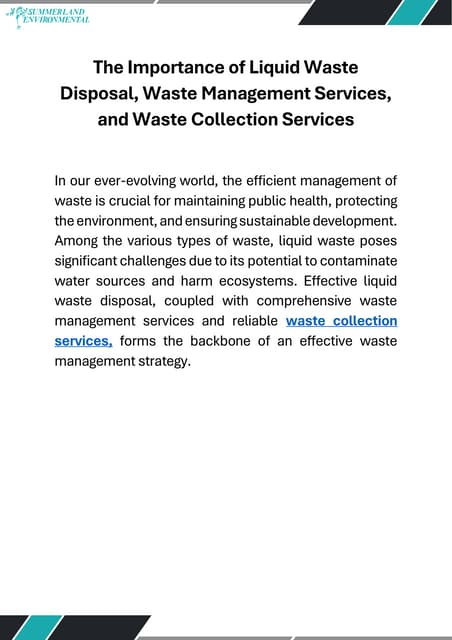More About Reclaim Waste
More About Reclaim Waste
Blog Article
Getting My Reclaim Waste To Work
Table of ContentsThe Buzz on Reclaim WasteThe 10-Second Trick For Reclaim WasteReclaim Waste Things To Know Before You Get ThisThe 8-Second Trick For Reclaim WasteThe Basic Principles Of Reclaim Waste
Domestic sewer waste refers to the waste and products from a residential septic container. The correct administration and disposal of residential sewer waste need fluid waste to be transferred to a sewer therapy plant where the proper methods and devices are used to detoxify and dispose of waste.
Commercial waste commonly includes prospective hazards, such as flammable products or a combination of fluid and strong waste products, and needs a more sophisticated and comprehensive disposal procedure. The disposal of industrial waste generally involves the filtration of waste before transport to ensure secure and appropriate disposal. Industrial waste is developed from byproducts and drainage of industrial processes and manufacturing.
This kind of waste can not use the exact same sewage monitoring transportation or procedures as septic or business liquids. The commercial waste administration process requires the examination and screening of liquid waste before it goes through the disposal procedure (liquid waste disposal). Overflow waste is the liquid waste that comes from overflow and excess stormwater in very booming locations or cities
Overflow waste can trigger contamination and flooding if not dealt with correctly. Guaranteeing proper waste monitoring can avoid disasters and minimize ecological injury.
The Best Guide To Reclaim Waste
Contact PROS Providers today to discover our waste monitoring and disposal services and the correct means to look after the fluid waste you generate.
(https://reclaimwaste1.edublogs.org/2024/11/12/efficient-liquid-waste-removal-and-disposal-your-complete-guide-to-sustainable-waste-management/)This so-called 'wastewater' is not only an essential source yet, after therapy, will be released to our land, rivers or the ocean. Utilized water from bathrooms, showers, baths, cooking area sinks, washings and commercial processes is understood as wastewater.

water made use of to cool machinery or tidy plant and devices). Stormwater, a form of wastewater, is drainage that flows from farming and metropolitan areas such as roofs, parks, yards, roads, courses and seamless gutters into stormwater drains pipes, after rain. Stormwater flows untreated straight to local creeks or rivers, ultimately reaching the ocean.
Some Known Details About Reclaim Waste
In Queensland, a lot of wastewater is dealt with at sewage treatment plants. Wastewater is moved from domestic or commercial websites through a system of sewers and pump terminals, known as sewerage reticulation, to a sewage treatment plant.
The Department of Natural Resources recommends city governments concerning handling, operating and maintaining sewerage systems and treatment plants. In unsewered locations, city governments may require owners to set up private or house sewer treatment systems to treat residential wastewater from bathrooms, kitchen areas, restrooms and laundries. The Division of Natural Resources authorizes the use of home systems when they are shown to be effective.
Most stormwater obtains no therapy. In some new neighborhoods, treatment of some stormwater to get website here rid of trash, sand and gravel has begun utilizing gross toxin catches. Wastewater treatment occurs in 4 phases: Gets rid of solid issue. Bigger solids, such as plastics and various other items incorrectly released to drains, are removed when wastewater is gone through displays.
Utilizes small living microorganisms recognizes as micro-organisms to damage down and eliminate remaining liquified wastes and great bits. Micro-organisms and wastes are included in the sludge.
7 Easy Facts About Reclaim Waste Shown
Nutrient elimination is not readily available at all sewer therapy plants since it calls for expensive specialised equipment. Clear fluid effluent generated after therapy might still have disease-causing micro-organisms - liquid waste disposal.

A lot of wastewater moves into the sewerage system. Under the Act, regional governments provide authorizations and licences for eco pertinent activities (ERAs) entailing wastewater launches that could have a regional impact.
5 Simple Techniques For Reclaim Waste
Or else, samples are taken for research laboratory analysis. Frequently lots of tests are needed to develop the levels of each of the various pollutants such as oils, hefty steels and pesticides in water. Surveillance provides accurate information concerning water high quality and can confirm that permit conditions are being satisfied. The information obtained with surveillance provides the basis for making water quality decisions.
Report this page